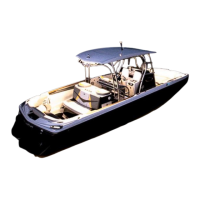Canvas Covers
The material used in constructing Bimini tops
and boat covers is made from 100 percent solu-
tion-dyed polyester ber with a urethane coating
to provide excellent water repellency and mildew
resistance. This design allows the material to be
easily maintained. By following a few simple care
and cleaning steps, the fabric will continue to
look good and maintain its ne qualities for sea-
sons to come.
Important Background Information
Because the fabrics are woven, they are
breathable. It’s also important to know that these
fabrics are treated with a uorocarbon nish,
which enhances water repellency. This nish re-
quires replenishment after vigorous cleaning.
Polyester fabric will not support the growth
of mildew. Mold and mildew need something on
which to grow and polyester fabric is not a desir-
able substance for such growth. Dirt or dust on
the fabric, however, is a perfect source for mildew
growth, which makes regular cleaning of the fabric
important.
There is no set time for when the fabric
should be cleaned, and the local environment has
a great deal to do with determining cleaning fre-
quency. Cleaning is required less frequently in a dry environment than in a humid
one where heavy foliage exists.
The material has an applied nish that deters mold and mildew growth, but it
does not make it mold-proof. Keeping the fabric free of dirt and foreign substances
is important in deterring mold growth.
Cleaning
One of the best ways to keep the material looking fresh and new, and to de-
lay the need for deep or vigorous cleaning, is to hose o fabrics with clear water
on at least a monthly basis with clear water. This practice will help prevent dirt
from becoming deeply embedded in the fabric, and it will eliminate the need for
more frequent and more vigorous cleanings.
In most environments, a thorough cleaning will be needed approximately
every two (2) years.
The fabric can be cleaned while still in the boat. When cleaning, it is impor-
tant to observe the following:
• Always use a natural soap—never detergent.
• Water should be cold to lukewarm, but never more than 100 degrees.
• Air dry only. Never apply heat to the fabric.
Begin by brushing o loose dirt, and then hose down the material. Prepare a
cleaning mixture of water and a mild, natural soap that is free of detergents. Use
a soft-bristle brush to clean, allowing the soap to soak in. Rinse thoroughly and
allow the fabric to thoroughly air dry.
If stubborn stains persist, you can use a diluted chlorine bleach/soap mixture
for spot cleaning of mildew, roof run-o and other similar stains. Please keep
in mind that chlorine bleach will not change the color of the fabric, but chlorine
bleach will eventually break down the ber of any fabric. Therefore, this cleaning
method should be used as infrequently as possible.
The cleaning mixture should be mixed as follows:
• Four ounces (one-half cup) of chlorine bleach.
• Two ounces (one-fourth cup) of natural soap.
• One gallon of water.
Clean with a soft-bristle brush and allow the mixture to
soak no longer than twenty (20) minutes. Rinse thoroughly
and allow to completely air dry. Repeat if necessary.
If the top or boat cover is suitable in size for a washing
machine, these steps should be followed:
• Use only natural soaps—no detergent.
• Wash and rinse in cold water.
• Air dry. (Never put the fabric in a dryer.)
As part of the nishing process, the material has been
treated with a uorocarbon nish, which enhances water re-
pellency. This nish is designed to last for several years, but it
must be replenished after a thorough cleaning. Based on test
results, the manufacturer recommends 303 High Tech Fabric
Guard™ as the preferred re-treatment product.
After cleaning and air drying, apply 303 in a thin, even coat.
When it has dried, apply a second thin, even coat. These two
(2) light coatings are more eective in restoring fabric water
resistance than a single heavy coating. Keep in mind that 303
High Tech Fabric Guard™ will work only as well as it is applied.
This means that the fabric must be free of dirt and detergents
or the Fabric Guard will wash away with the dirt particles.
Fabrics should be retreated after thorough cleaning or after
ve (5) years of use.
MasterCraft 2012 Owners Manual • Care and Maintenance • Page 4-6

